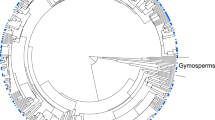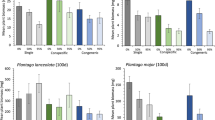Abstract
Both innate and evolutionarily increased ecophysiological advantages can contribute to vigorous growth, and eventually to invasiveness of alien plants. Little effort has been made to explore the roles of innate factors of alien plants in invasiveness and the effects of CO2 enrichment on alien plant invasions. To address these problems, we compared invasive Eupatorium adenophorum, its native conspecific, and a native congener (E. japonicum) under ambient and doubled atmospheric CO2 concentrations. Native E. adenophorum from Mexico grew slower than invasive E. adenophorum but faster than native E. japonicum under both CO2 concentrations. The faster growth rate of invasive E. adenophorum was associated with higher photosynthetic capacity and leaf area ratio. For invasive E. adenophorum, the higher photosynthetic capacity was associated with higher nitrogen (N) allocation to photosynthesis, which was related to lower leaf mass per area; the higher leaf area ratio was due to lower leaf mass per area and higher leaf mass fraction. Tradeoff between N allocations to photosynthesis versus defenses was found. CO2 enrichment significantly increased relative growth rate and biomass accumulation by increasing actual photosynthetic rate for all studied materials. However, the relative increase in growth was not significantly different among them. CO2 enrichment did not influence N allocation to photosynthesis, but increased N allocation to cell walls. The reduced leaf N content decreased N content in photosynthesis, explaining the down-regulation of photosynthetic capacity under prolonged elevated CO2 concentration. Our results indicate that both innate and evolutionary advantages in growth and related ecophysiological traits contribute to invasiveness of invasive E. adenophorum, and CO2 enrichment may not aggravate E. adenophroum’s invasion in the future.



Similar content being viewed by others
Abbreviations
- N bioenerg :
-
Nitrogen contents in bioenergetics
- N carbox :
-
Carboxylation
- N CG :
-
Cyanogenic glycosides
- N CW :
-
Cell walls
- N D :
-
Defenses
- N LHC :
-
Light-harvesting components
- N photosynth :
-
All components of the photosynthetic apparatus
- N L :
-
Total leaf nitrogen content
- P max :
-
Light-saturated photosynthetic rate
- PNUE:
-
Photosynthetic nitrogen-use efficiency
References
Ainsworth EA, Long SP (2005) What have we learned from 15 years of free-air CO2 enrichment (FACE)? A meta-analytic review of the responses of photosynthesis, canopy properties and plant production to rising CO2. New Phytol 165:351–372
Akinnifesi FK, Kang BT, Ladipo DO (1999) Structural root form and fine root distribution of some woody species evaluated for agroforestry systems. Agrofor Syst 42:121–138
Bauhus J, Messier C (1999) Soil exploitation strategies of fine-roots in different tree species of the southern boreal forest of eastern Canada. Can J For Res 29:260–273
Blossey B, Notzold R (1995) Evolution of increased competitive ability in invasive nonindigenous plants: a hypothesis. J Ecol 83:887–889
Bossdorf O, Auge H, Lafuma L, Rogers WE, Siemann E, Prati D (2005) Phenotypic and genetic differentiation between native and introduced plant populations. Oecologia 144:1–11
Caruso CM, Maherali H, Sherrard M (2006) Plasticity of physiology in Lobelia: testing for adaptation and constraint. Evolution 60:980–990
Colautti RI, Maron JL, Barrett SCH (2008) Common garden comparisons of native and introduced plant populations: latitudinal clines can obscure evolutionary inferences. Evol Appl 2:187–199
Cronk QCB, Fuller JL (1995) Plant invaders: the threat to natural ecosystems. Chapman and Hall, London
Daehler CC (2003) Performance comparisons of co-occurring native and alien invasive plants: implications for conservation and restoration. Ann Rev Ecol Evol Syst 34:183–211
Davis MA, Grime JP, Thompson K (2000) Fluctuating resources in plant communities: a general theory of invisibility. J Ecol 88:528–534
Evans JR, Seemann JR (1989) The allocation of protein nitrogen in the photosynthetic apparatus: costs, consequences and control. In: Brigs WR (ed) Photosynthesis. Liss AR, New York, pp 183–205
Feng YL (2008a) Nitrogen allocation and partitioning in invasive and native Eupatorium species. Physiol Plant 132:350–358
Feng YL (2008b) Photosynthesis, nitrogen allocation and specific leaf area in invasive Eupatorium adenophorum and native Eupatorium japonicum grown at different irradiances. Physiol Plant 133:318–326
Feng YL, Auge H, Ebeling SK (2007) Invasive Buddleja davidii allocates more nitrogen to its photosynthetic machinery than five native woody species. Oecologia 153:501–510
Feng YL, Fu GL, Zheng YL (2008) Specific leaf area relates to the differences in leaf construction cost, photosynthesis, nitrogen allocation and use efficiencies between invasive and noninvasive alien congeners. Planta 228:383–390
Feng YL, Lei YB, Wang RF, Callaway RM, Valiente-Banuet A, Inderjit LiYP, Zheng YL (2009) Evolutionary tradeoffs for nitrogen allocation to photosynthesis versus cell walls in an invasive plant. Proc Natl Acad Sci USA 106:1853–1856
Grotkopp E, Rejmánek M (2007) High seedling relative growth rate and specific leaf area are traits of invasive species: phylogenetically independent contrasts of woody angiosperms. Am J Bot 94:526–532
Grotkopp E, Rejmánek M, Rost TL (2002) Toward a causal explanation of plant invasiveness: seedling growth and life-history strategies of 29 pine (Pinus) species. Am Nat 159:396–419
Hattenschwiler S, Koner C (2003) Does elevated CO2 facilitate naturalization of the non-indigenous Prunus laurocerasus in Swiss temperate forests? Func Ecol 17:778–785
Hull-Sanders HM, Clare R, Johnson RH, Merer GA (2007) Evaluation of the evolution of increased competitive ability (EICA) hypothesis: loss of defense against generalist but not specialist herbivores. J Chem Ecol 33:781–799
IPCC (2007) Summary for policymakers. In: Solomon S, Qin D, Manning M, Chen Z, Marquis M, Averyt KB, Tignor M, Miller HL (eds) Climate change 2007: the physical science basis. Cambridge University Press, Cambridge
Johnson MTL (2007) Genotype-by-environment interactions lead to variable selection on life-history strategy in Common Evening Primrose (Oenothera biennis). J Evol Biol 20:190–200
Joshi J, Vrieling K (2005) The enemy release and EICA hypothesis revisited: incorporating the fundamental difference between specialist and generalist herbivores. Ecol Lett 8:704–714
Keane RM, Crawley MJ (2002) Exotic plant invasions and the enemy release hypothesis. Trends Ecol Evol 16:199–204
Liang WS (2003) Drought stress increases both cyanogenesis and β-cyanoalanine synthase activity in tobacco. Plant Sci 165:1109–1115
Lichtenthaler HK, Wellburn AR (1983) Determination of total carotenoids and chlorophyll a and b of leaf extracts in different solvents. Biochem Soc Trans 603:591–592
Liu H, Stiling P (2006) Testing the enemy release hypothesis: a review and meta-analysis. Biol Inv 8:1535–1545
Medlyn BE, Badeck FW, Depury DGG, Barton CV, Broadmeadow M, Ceulemans R, De Angells P, Forstreuter M, Jach MF, Kellomaki S, Laitat E, Marek M, Philippot S, Rey A, Strassemeyer J, Laitinen K, Liozon R, Portier B, Roberntz P, Wang K, Jarvis PG (1999) Effects of elevated [CO2] on photosynthesis in European forest species: a meta-analysis of model parameters. Plant Cell Environ 22:1475–1495
Mitchell CE, Power AG (2003) Release of invasive plants from fungal and viral pathogens. Nature 421:625–627
Müller-Schärer H, Schaffner U, Steinger T (2004) Evolution in invasive plants: implications for biological control. Trends Ecol Evol 19:417–422
Niinemets U, Tenhunen JD (1997) A model separating leaf structural and physiological effects on carbon gain along light gradients for the shade-tolerant species Acer saccharum. Plant Cell Environ 22:845–866
Poorter L (1999) Growth responses of 15 rain-forest tree species to a light gradient: the relative importance of morphological and physiological traits. Funct Ecol 13:396–410
Sasek TW, Strain BR (1991) Effects of CO2 enrichment on the growth and morphology of a native and an introduced honeysuckle vine. Am J Bot 78:69–75
Siemann E, Rogers WE (2001) Genetic differences in growth of an invasive tree species. Ecol Lett 4:514–518
Smith JM, Arteca RN (2000) Molecular control of ethylene production by cyanide in Arabidopsis thaliana. Physiol Plant 109:180–187
Smith SD, Huxman TE, Zitzer SF, Charlet TN, Housman DC, Coleman JS, Fenstermaker LK, Seemann JR, Nowak RS (2000) Elevated CO2 increases productivity and invasive species success in an arid ecosystem. Nature 408:79–82
Stiling P, Moon DC, Hunter MD, Colson J, Rossi AM, Hymus GJ, Drake BG (2003) Elevated CO2 lowers relative and absolute herbivore density across all species of a scrub-oak forest. Oecologia 134:82–87
Takashima T, Hikosaka K, Hirose T (2004) Photosynthesis or persistence: nitrogen allocation in leaves of evergreen and deciduous Quercus species. Plant Cell Environ 27:1047–1054
van Kleunen M, Stephan MA, Schmid B (2006) [CO2]- and density-dependent competition between grassland species. Global Change Biol 12:2175–2218
Willis CG, Ruhfel BR, Primack RB, Miller-Rushing AJ, Losos JB, Davis CC (2010) Favorable climate change response explains non-native species’ success in Thoreau’s woods. PLoS ONE 5(1):e8878
Zheng YL, Feng YL, Liu WX, Liao ZY (2009) Growth, biomass allocation, morphology and photosynthesis of invasive Eupatorium adenophorum and its native congeners grown at different irradiances. Plant Ecol 203:263–271
Zou JW, Rogers WE, Siemann E (2007) Differences in morphological and physiological traits between native and invasive populations of Sapium Sebiferum. Funct Ecol 21:721–730
Zou JW, Rogers WE, Siemann E (2009) Plasticity of Sapium sebiferum seedling growth to light and water resources: Inter- and intraspecific comparisons. Basic Appl Ecol 10:79–88
Acknowledgments
The authors are grateful to Jingdong Nature Reserve Administration Bureau and National Forest Ecosystem Research Station at Ailaoshan for logistic supports, and Yang-Ping Li, Yong-Jiang Zhang, Jin-Hua Qi, and Xin Luo for assistances in measurements. This study was founded by the Projects of Natural Science Foundation of China (30830027, 30900220), the Western Ph. D Program of Chinese Academy of Sciences, the Applied Basic Study Project of Yunnan Province (2009CD119), and Knowledge Innovation Program of Chinese Academy of Sciences (KSCX2-YW-Z-1019).
Author information
Authors and Affiliations
Corresponding author
Rights and permissions
About this article
Cite this article
Lei, Y.B., Feng, Y.L., Zheng, Y.L. et al. Innate and evolutionarily increased advantages of invasive Eupatorium adenophorum over native E. japonicum under ambient and doubled atmospheric CO2 concentrations. Biol Invasions 13, 2703–2714 (2011). https://doi.org/10.1007/s10530-011-9940-y
Received:
Accepted:
Published:
Issue Date:
DOI: https://doi.org/10.1007/s10530-011-9940-y




